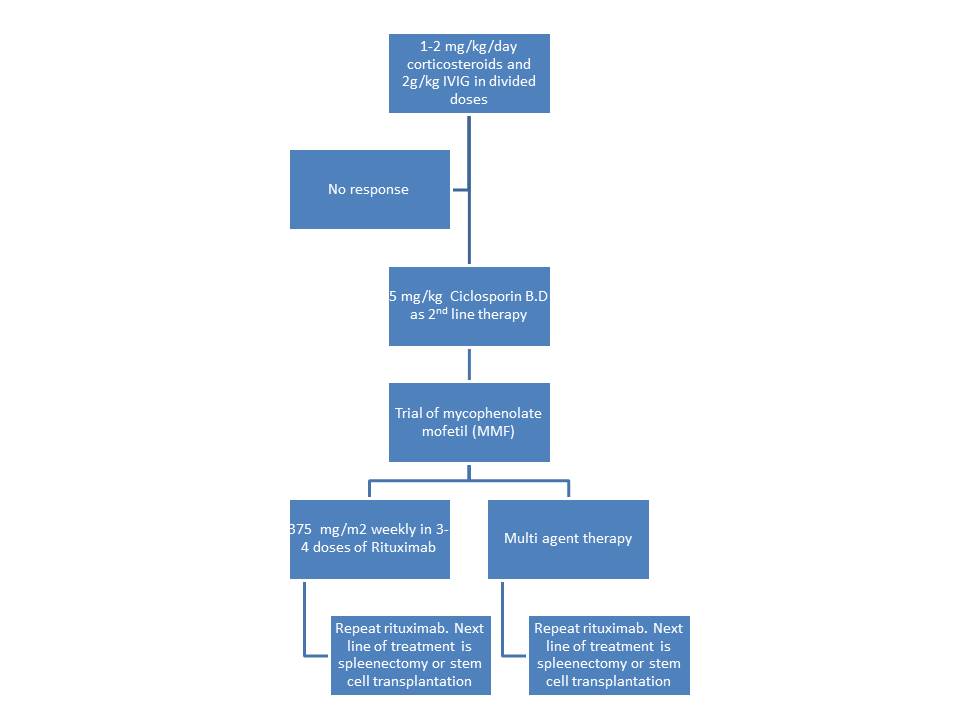Evans syndrome medical therapy
Jump to navigation
Jump to search
|
Evans syndrome Microchapters |
|
Diagnosis |
|---|
|
Treatment |
|
Case Studies |
|
Evans syndrome medical therapy On the Web |
|
American Roentgen Ray Society Images of Evans syndrome medical therapy |
|
Risk calculators and risk factors for Evans syndrome medical therapy |
Editor-In-Chief: C. Michael Gibson, M.S., M.D. [1]; Associate Editor(s)-in-Chief: Ammu Susheela, M.D. [2]
Overview
Pharmacologic medical therapies for Evans syndrome include prednisone, intravenous immunoglobulin, and rituximab.
Medical Therapy
- The treatment for Evan’s syndrome will involve close monitoring of hemoglobin and platelet counts. To increase the number of platelets and red blood cells in the blood, the patient may be given a corticosteroid such as prednisone. Prednisone will reduce the destruction of the platelets and red blood cells. A certain level of prednisone may need to be taken for the patient's entire life to prevent the levels of platelets and RBCs from dropping. Further treatment may be necessary with immune system suppressing drugs to block the production of the antibodies. To specifically treat the anemia of the syndrome, it may be necessary to provide the child with new RBCs by a blood transfusion. It has not been shown to be effective to transfuse platelets in a similar fashion to treat the thrombocytopenia[1]
- Initial treatment is with glucocorticoid corticosteroids or intravenous immunoglobulin, a procedure that is also used in idiopathic thrombocytopenic purpura cases.[2][3] In children, good response to a short steroid course is achieved in approximately 80 percent of cases.[4] Although the majority of cases initially respond well to treatment, relapses are not uncommon and immunosuppressive drugs (e.g. ciclosporin,[5][6] mycophenolate mofetil, vincristine[7] and danazol[8]) are subsequently used, or combinations of these.[9]
- The off-label use of rituximab (trade name Rituxan) has produced some good results in acute and refractory cases,[4][10] although further relapse may occur within a year. Relapses are not uncommon.[11]
- The only prospect for a permanent cure is the high-risk option of an allogeneic hematopoietic stem cell transplantation (SCT).[12][13]

References
- ↑ Management of Evans syndrome. Wiley (2016). http://onlinelibrary.wiley.com/doi/10.1111/j.1365-2141.2005.05809.x/full Accessed on January 11, 2016
- ↑ Nuss R, Wang W (1987). "Intravenous gamma globulin for thrombocytopenia in children with Evans syndrome". The American journal of pediatric hematology/oncology. 9 (2): 164–7. doi:10.1097/00043426-198722000-00012. PMID 2438958.
- ↑ Mehta JB, Singhal SB, Mehta BC (1992). "Intravenous immunoglobulin therapy of idiopathic thrombocytopenia". The Journal of the Association of Physicians of India. 40 (5): 340–2. PMID 1483999.
- ↑ 4.0 4.1 Zecca M; Nobili B; Ramenghi U; et al. (15 May 2003). "Rituximab for the treatment of refractory autoimmune hemolytic anemia in children". Blood. 101 (10): 3857–61. doi:10.1182/blood-2002-11-3547. PMID 12531800.
- ↑ Emilia G, Messora C, Longo G, Bertesi M (1996). "Long-term salvage treatment by cyclosporin in refractory autoimmune haematological disorders". Br. J. Haematol. 93 (2): 341–4. doi:10.1046/j.1365-2141.1996.4871026.x. PMID 8639426.
- ↑ Liu H, Shao Z, Jing L (2001). "[The effectiveness of cyclosporin A in the treatment of autoimmune hemolytic anemia and Evans syndrome]". Zhonghua Xue Ye Xue Za Zhi (in Chinese). 22 (11): 581–3. PMID 11855146.
- ↑ Yokoyama K; Kojima M; Komatsumoto S; et al. (1992). "[Thrombotic thrombocytopenic purpura achieving complete remission by slow infusion of vincristine]". Rinsho Ketsueki (in Japanese). 33 (8): 1084–9. PMID 1404865.
- ↑ Koike M; Ishiyama T; Saito K; et al. (1993). "[Effective danazol therapy for a patient with Evans syndrome]". Rinsho Ketsueki (in Japanese). 34 (2): 143–6. PMID 8492411.
- ↑ Scaradavou A, Bussel J (1995). "Evans syndrome. Results of a pilot study utilizing a multiagent treatment protocol". J. Pediatr. Hematol. Oncol. 17 (4): 290–5. doi:10.1097/00043426-199511000-00003. PMID 7583383.
- ↑ Shanafelt TD, Madueme HL, Wolf RC, Tefferi A (November 2003). "Rituximab for immune cytopenia in adults: idiopathic thrombocytopenic purpura, autoimmune hemolytic anemia, and Evans syndrome" (PDF). Mayo Clin. Proc. 78 (11): 1340–6. doi:10.4065/78.11.1340. PMID 14601692.
- ↑ Mathew P, Chen G, Wang W (1997). "Evans syndrome: results of a national survey". J. Pediatr. Hematol. Oncol. 19 (5): 433–7. doi:10.1097/00043426-199709000-00005. PMID 9329465.
- ↑ Martino R, Sureda A, Brunet S (1997). "Peripheral blood stem cell mobilization in refractory autoimmune Evans syndrome: a cautionary case report" (PDF). Bone Marrow Transplant. 20 (6): 521. doi:10.1038/sj.bmt.1700924. PMID 9313889.
- ↑ Oyama Y, Papadopoulos EB, Miranda M, Traynor AE, Burt RK (2001). "Allogeneic stem cell transplantation for Evans syndrome". Bone Marrow Transplant. 28 (9): 903–5. doi:10.1038/sj.bmt.1703237. PMID 11781654.